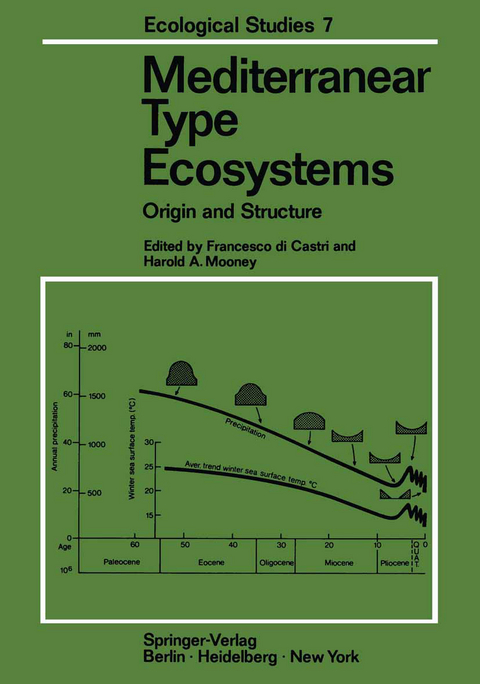
Mediterranean Type Ecosystems
Springer Berlin (Verlag)
978-3-642-65522-7 (ISBN)
Section I: Convergence in Ecosystems.- 1. Historical View of the Concept of Ecosystem Convergence.- Section II: Physical Geography of Lands with Mediterranean Climates.- 1. distribution and Peculiarity of Mediterranean Ecosystems.- 2. Climatographical Comparisons between Chile and the Western Coast of North America.- 3. The Physiography of the Mediterranean Lands with Special Emphasis on California and Chile.- 4. Geomorphological Processes and Characteristic Landforms in the Mediterranean Regions of the World.- 5. Analogies between the Soil and Vegetation Types of Italy, Greece, and California.- Section III: Vegetation in Mediterranean Climate Regions.- 1. Structure and Function of the California Chaparral - an Example from San dimas.- 2. Structure and Functional Response of Ecosystems in the Mediterranean Climate of Australia.- 3. The Role of the Secondary Plant Chemistry in the Evolution of the Mediterranean Scrub Vegetation.- 4. Comparative Anatomy of Sclerophylls of Mediterranean Climatic Areas.- Section IV: Soil Systems in Mediterranean Climate Regions.- 1. Soil Animals in Latitudinal and Topographical Gradients of Mediterranean Ecosystems.- 2. Microbial Activity under Seasonal Conditions of Drought in Mediterranean Climates.- 3. Soil-Vegetation Relationships in Mediterranean Ecosystems of Southern France.- Section V: Plant Biogeography.- 1. The Evolution of Mediterranean Floras.- 2. History of the Mediterranean Ecosystem in California.- Section VI: Animal Biogeography and Ecological Niche.- 1. Biogeography of Soil Beetles in Mediterranean Regions.- 2. Biogeography of Pseudoscorpions in the Mediterranean Regions of the World.- 3. Parallel Evolution and Bird Niches.- 4. Ecological Convergence of the Lizard Faunas of the Chaparral Communities in Chile andCalifornia.- 5. Segregation of Lizard Niches in the Mediterranean Region of Chile.- Section VII: Human Activities Affecting Mediterranean Ecosystems.- 1. Man's Impact on the Several Regions with Mediterranean Climates.- 2. The Human Degradation of Mediterranean Landscapes in Israel.
| Erscheint lt. Verlag | 11.11.2011 |
|---|---|
| Reihe/Serie | Ecological Studies |
| Zusatzinfo | XII, 408 p. |
| Verlagsort | Berlin |
| Sprache | englisch |
| Maße | 170 x 244 mm |
| Gewicht | 733 g |
| Themenwelt | Naturwissenschaften ► Biologie ► Ökologie / Naturschutz |
| Naturwissenschaften ► Geowissenschaften ► Geografie / Kartografie | |
| Naturwissenschaften ► Geowissenschaften ► Mineralogie / Paläontologie | |
| Schlagworte | anatomy • animals • biogeography • bird • Chemistry • Climate • ecosystem • Ecosystems • Evolution • Fauna • Flora • physical geography • Plant • Soil • Vegetation |
| ISBN-10 | 3-642-65522-X / 364265522X |
| ISBN-13 | 978-3-642-65522-7 / 9783642655227 |
| Zustand | Neuware |
| Haben Sie eine Frage zum Produkt? |
aus dem Bereich


